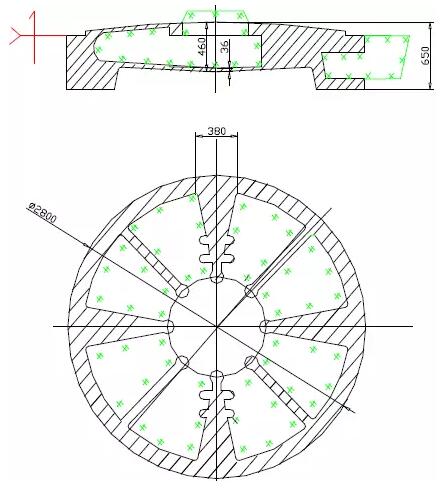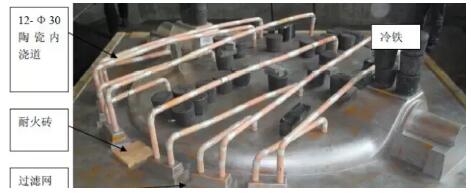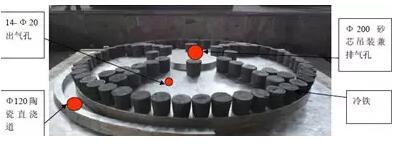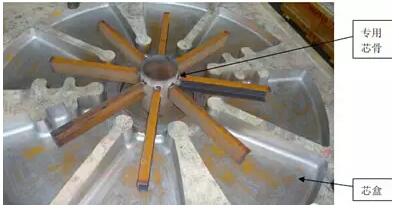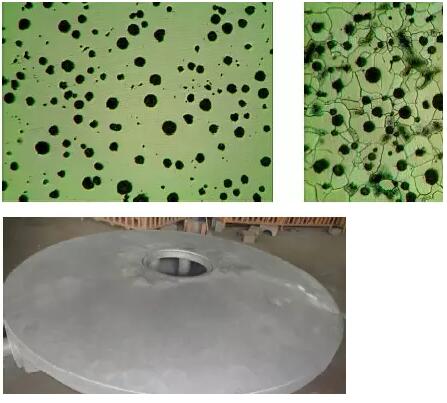1. Structural analysis (1) This butterfly valve has a circular pie-shaped structure. The internal cavity is connected and supported by 8 stiffeners. The top Φ620 hole communicates with the internal cavity. The rest are closed shapes. The sand core is difficult to fix and is easy to deform. Both the exhaust and the cleaning of the inner cavity bring great difficulties, as shown in Figure 1. (2) The wall thickness of castings varies greatly, the maximum wall thickness is 380mm, and the minimum wall thickness is only 36mm. When the casting solidifies, the temperature difference is large, and the uneven shrinkage is easy to cause shrinkage holes and shrinkage defects to cause water seepage in the hydraulic test. 2. Process plan design: (1) The parting surface is shown in Figure 1. Put one end with a hole in the upper box, and make an integral sand core in the middle cavity. The core head is appropriately lengthened to facilitate the fastening of the sand core and the sand core when turning the box. Stable, the length of the two blind hole cantilever cores on the side is greater than the length of the hole, so that the center of gravity of the entire sand core is biased to the side of the core to ensure that the sand core is fixed and stable. (2) Using semi-closed pouring system, ∑F inside: ∑F horizontal: ∑F straight=1:1.5:1.3, the sprue uses an inner diameter Φ120 ceramic pipe, and two 200×100×40mm refractory bricks are placed at the bottom to To prevent molten iron from directly impacting the sand mold, a 150×150×40 foam ceramic filter is installed at the bottom of the runner, and 12 ceramic pipes with an inner diameter of Φ30 are evenly connected to the bottom of the casting through the sink at the bottom of the filter to form a bottom casting pouring scheme. As shown in Figure 2. (3) Place 14 ∮20 cavity vent holes on the upper mold, and place a Φ200 sand core vent hole in the middle of the core head, and place chilled iron chilling on the thick part to ensure balanced solidification of the casting, and use graphitization expansion principle to cancel Feeding riser to improve the production rate of the process, the flask size is 3600×3600×1000/600mm, welded with 25mm thick steel plate to ensure sufficient strength and rigidity, as shown in Figure 3. 3. Process control (1) Modeling: Before modeling, use a Φ50×50mm standard sample to test the compressive strength of the resin sand ≥3.5MPa, and the chilled iron and runners should be tightly compacted to ensure that the sand mold has sufficient strength to offset the graphite produced when the molten iron is solidified To prevent the molten iron from impacting the runner for a long time to cause sand washing. (2) Core making: This sand core is divided into 8 equal parts by 8 reinforcing ribs, which are connected by a middle cavity. There are no other support and exhaust parts except the middle core head. If the sand cannot be processed properly The core is fixed and vented. After pouring, there will be sand core displacement and pores. Due to the large overall area of ​​the sand core, it is divided into eight parts. It must have sufficient strength and rigidity to ensure that the sand core is not damaged after being removed from the mold. No deformation occurs after pouring, so as to ensure the uniformity of the wall thickness of the casting. For this reason, we specially made a special core bone, and used a vent rope to tie on the core bone to lead out the exhaust air from the core, and ensure the tightness of the sand mold when making the core. Reality, as shown in Figure 4. (3) Combining the box: Considering the difficulty of cleaning the inner cavity of this butterfly valve, the entire sand core is painted with two layers of paint, the first layer is brushed with alcohol-based zirconium paint (Baume 45-55), and the first layer is burned. After drying, brush the second layer (Baume 35-45) with alcohol-based magnesium paint to prevent the casting from sticking to sand and sintering and cannot be cleaned. The core head part is hung on the Φ200 steel pipe of the core bone main structure with three M25 screw rods, and the upper mold sand box is fixed and locked with a screw cap, and the wall thickness of each part is checked for uniformity. 4. Melting and pouring process (1) Use Benxi low P, S, Ti high-quality Q14/16# pig iron and add it at a ratio of 40% to 60%; P, S, Ti, Cr, Pb and other trace elements are strictly controlled in the scrap steel, and no rusty oil stains are allowed. , The adding ratio is 25%~40%; the recharge material must be shot blasted before use to ensure that the charge is clean. (2) Control of main components after furnace: C: 3.5-3.65%, Si: 2.2%~2.45%, Mn: 0.25%~0.35%, P≤0.05%, S: ≤0.01%, Mg (residual): 0.035% ~0.05%, under the premise of ensuring spheroidization, the lower limit of Mg (residual) should be taken as far as possible. (3) Spheroidizing treatment: using low magnesium and low rare earth spheroidizing agent, adding ratio 1.0%~1.2%, conventional flushing method spheroidizing treatment, one-time inoculation 0.15% covering the bottom spheroidizing agent, spheroidizing is completed After the slag, it is subcontracted for the second inoculation 0.35%, and the flow inoculation is 0.15% during pouring. (4) The low-temperature quick pouring process is adopted, the pouring temperature is 1320℃~1340℃, and the pouring time is 70~80s. The molten iron cannot be cut off during pouring, and the sprue cup is always in a full state to prevent gas and inclusions from being drawn into the runner through the runner. Cavity. 5. Testing results of castings (1) Test the tensile strength of the attached casting test block: 485MPa, elongation: 15%, Brinell hardness HB187. (2) The spheroidization rate is 95%, the graphite size is grade 6, and the pearlite is 35%. The metallographic structure is shown in Figure 5. (3) No recordable defects were found in the secondary flaw detection of UT and MT in important parts. (4) The appearance is smooth and clean (see Figure 6), without casting defects such as sand, slag, and cold barriers, uniform wall thickness, and dimensions in line with the requirements of the drawings. (5) After processing, the 20kg/cm2 water pressure test did not show any leakage. 6. Conclusion In view of the structural characteristics of this butterfly valve, focus on the design of the process plan, the production and fixing of the sand core, and the use of zirconium coatings to solve the problems of unstable and easy deformation of the middle sand core and difficulty in sand cleaning. The setting of vent holes avoids the possibility of porosity in the casting. From the charge control, the runner system, the foam ceramic filter and the ceramic inner runner technology are used to ensure the purity of the molten iron. After multiple inoculation treatments, the metallographic structure and various aspects of the casting are ensured. The comprehensive performance has reached the customer's standard requirements. K Series Energy-saving Type Shape Molding Machine Eps Foam Box Machine,Thermocol Box Machine,Eps Decoration Product Machine,High Configuration Eps Machine Zhejiang Huasheng Machinery Equipment Co.,Ltd , https://www.zjhsfoammachine.com